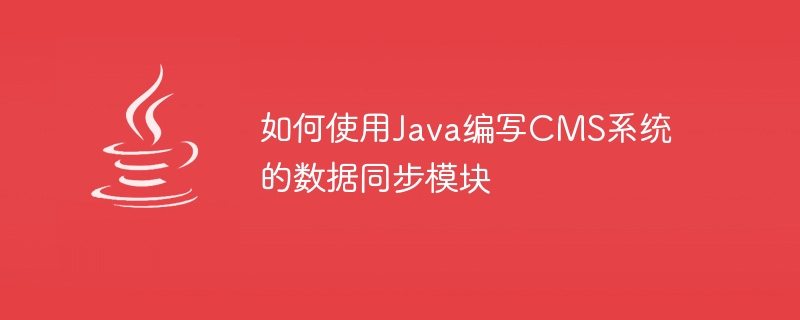

How to use Java to write the data synchronization module of the CMS system
Introduction:
With the development of the information age and the popularity of the Internet, content management systems (CMS) It has been widely used in all walks of life. Among different user groups, content management requires the synchronization of multiple data sources, which requires an efficient and reliable data synchronization module. This article will introduce how to use Java to write the data synchronization module of the CMS system and provide relevant code examples.
1. Overview
Data synchronization refers to the process of exchanging, synchronizing and copying data between multiple data sources. In the CMS system, the data synchronization module is responsible for synchronizing data from one data source (such as database, file system, etc.) to another data source to ensure data consistency and updateability.
2. Design Ideas
When designing the data synchronization module, we need to consider the following aspects:
3. Code Example
The following is a simple example of using Java to write a CMS system data synchronization module.
import org.apache.commons.dbcp2.BasicDataSource;
// 源数据源配置
BasicDataSource sourceDataSource = new BasicDataSource();
sourceDataSource.setDriverClassName("com.mysql.cj.jdbc.Driver");
sourceDataSource.setUrl("jdbc:mysql://localhost:3306/source_database");
sourceDataSource.setUsername("source_user");
sourceDataSource.setPassword("source_password");
// 目标数据源配置
BasicDataSource targetDataSource = new BasicDataSource();
targetDataSource.setDriverClassName("com.mysql.cj.jdbc.Driver");
targetDataSource.setUrl("jdbc:mysql://localhost:3306/target_database");
targetDataSource.setUsername("target_user");
targetDataSource.setPassword("target_password");import java.sql.*;
public class DataSync {
public void syncData() {
Connection sourceConn = null;
Connection targetConn = null;
try {
// 建立源数据源和目标数据源的连接
sourceConn = sourceDataSource.getConnection();
targetConn = targetDataSource.getConnection();
// 执行源数据源的查询操作
Statement stmt = sourceConn.createStatement();
ResultSet rs = stmt.executeQuery("SELECT * FROM source_table");
// 执行目标数据源的更新操作
PreparedStatement pstmt = targetConn.prepareStatement("INSERT INTO target_table (col1, col2) VALUES (?, ?)");
while (rs.next()) {
// 读取源数据源中的数据
int col1 = rs.getInt("col1");
String col2 = rs.getString("col2");
// 插入数据到目标数据源
pstmt.setInt(1, col1);
pstmt.setString(2, col2);
pstmt.executeUpdate();
}
// 关闭数据库连接
rs.close();
stmt.close();
pstmt.close();
} catch (SQLException e) {
e.printStackTrace();
} finally {
// 关闭数据库连接
try {
if (sourceConn != null) sourceConn.close();
if (targetConn != null) targetConn.close();
} catch (SQLException e) {
e.printStackTrace();
}
}
}
}DataSync dataSync = new DataSync(); dataSync.syncData();
4. Summary
This article introduces how to use Java to write the data synchronization module of the CMS system and provides corresponding code examples. By rationally selecting data sources, designing synchronization methods and strategies, and using appropriate fault-tolerant mechanisms, efficient and reliable CMS data synchronization can be achieved. Of course, in actual applications, more detailed design and development are required based on specific business needs.
The above is the relevant content on how to use Java to write the data synchronization module of the CMS system. I hope it will be helpful to you!
The above is the detailed content of How to use Java to write the data synchronization module of the CMS system. For more information, please follow other related articles on the PHP Chinese website!
